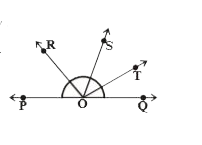If a ray stands on a line, then the sum of the two adjacent angles so formed is............... .Solution in Punjabi
Step by step video & image solution for If a ray stands on a line, then the sum of the two adjacent angles so formed is............... . by Maths experts to help you in doubts & scoring excellent marks in Class 9 exams.
Updated on:21/07/2023Topper's Solved these Questions
Similar Questions
The cost of a note book is twice the cost of a pen. Write a linear equation in two variables to represent this statement.
View SolutionIs zero a rational number ? Can you write in the form pq where p and q are integers and q≠0 ?
View SolutionIf a ray stands on a line; then the sum of the adjacent angles so formed is 180∘
View SolutionFill in the blanks so as to make the following statements true: (i) If one angle of a linear pair is acute, then its other angle will be .......... (ii) A ray stands on a line, then the sum of the two adjacent angles so formed is .................. (iii) If the sum of two adjacent angles is 180∘, then the ............ arms of the two angles are opposite rays.
View SolutionRead the following two statements which are taken as axiom:
(i) If two lines intersect each other , then the vertically opposite angles are not equal.
(ii) If a ray stands on a line , then the sum of two adjacent angles, so formed is equal to 180∘.
Is this system of axioms consistent ? Justify your answer.
View Solutionनिम्नलिखित रिक्तस्थनो की पूर्ति इस प्रकार कीजिए की प्रत्येक कथन सत्य हो:
(i) यदि रैखिक युग्म का एक कोण न्यून कोण हो, तो इसका दूसरा कोण .......होगा|
(ii) यदि एक किरण एक रेखा पर आधारित है, तो इस प्रकार बने आसन्न कोणों का योग ........होगा|
(iii) यदि दो आसन्न कोणों का योगफल 180∘ हो, तो इन कोणों की भुजाएं ........विपरीत किरणें होती है |
View Solutionयदि कोई किरण किसी रेखा पर स्थित हो तो जो दो आसन्न कोण बनते हैं उनका योग........................ है।
View Solutionयदि एक किरण किसी रेखा पर खड़ी हो तो बने आसन्न कोण का योग कितना होगा?
View Solutionयदि दो आसन्न कोणों का योग……………..हो तब वे रैखिक युग्म बनाते है।
View SolutionIf the sum of two adjacent angles is 180∘, then the ___ arms of the two angles are opposite rays.
View SolutionIn the adjacent figure ray OS stands on a line PQ. Ray OR and ray OT are angle bisectors of ∠POS and ∠SOQ respectively. Find ∠ROT.

View SolutionIn the adjacent figure ray OS stands on a line PQ. Ray OR and ray OT are angle bisectors of ∠POS and ∠SOQ respectively. Find ∠ROT.

View SolutionIn the adjacent figure ray OS stands on a line PQ. Ray OR and ray OT are angle bisectors of ∠POS and ∠SOQ respectively. Find ∠ROT.

View SolutionFill in the blanks so as to make the following statements true: (i) If one angle of a linear pair is acute, then its other angle will be .......... (ii) A ray stands on a line, then the sum of the two adjacent angles so formed is .................. (iii) If the sum of two adjacent angles is 1800, then the ............ arms of the two angles are opposite rays.
View SolutionThe following statements are considered to be postulated: (i) If two lines intersect, the vertically opposite angles are not equal. (ii) If a ray is standing on a line, then the sum of the two adjacent coops obtained in this way 180^@ Happen. Is this body of recipients compatible?
View SolutionIf a ray stands on a line, then the sum of the two adjacent angles so formed is............... .
View Solution
